Adelaide University: Cost Planning & Management Review Report
VerifiedAdded on 2023/06/01
|22
|4511
|84
Report
AI Summary
This report presents a comprehensive review of cost planning and management for a residential development project in Adelaide, undertaken due to global economic uncertainties affecting the Australian residential market. The review includes a total measurement of the Gross Floor Area (GFA) using Fully Enclosed Covered Area (FECA) and Unenclosed Covered Area (UCA) calculations, providing indicative advice on the expected order of cost for the development, assessing functional areas, and reviewing the design to assess value to the client. The report also explores value management options, recommends a suitable contract type, and suggests tender documentation based on the contract advice. The analysis incorporates various cost planning tools and techniques, such as cost planning maps, bottom-up estimates, and parametric estimates, to provide a thorough assessment of the project's financial viability, with the aim of informing the developer's decision on whether to proceed with the investment.
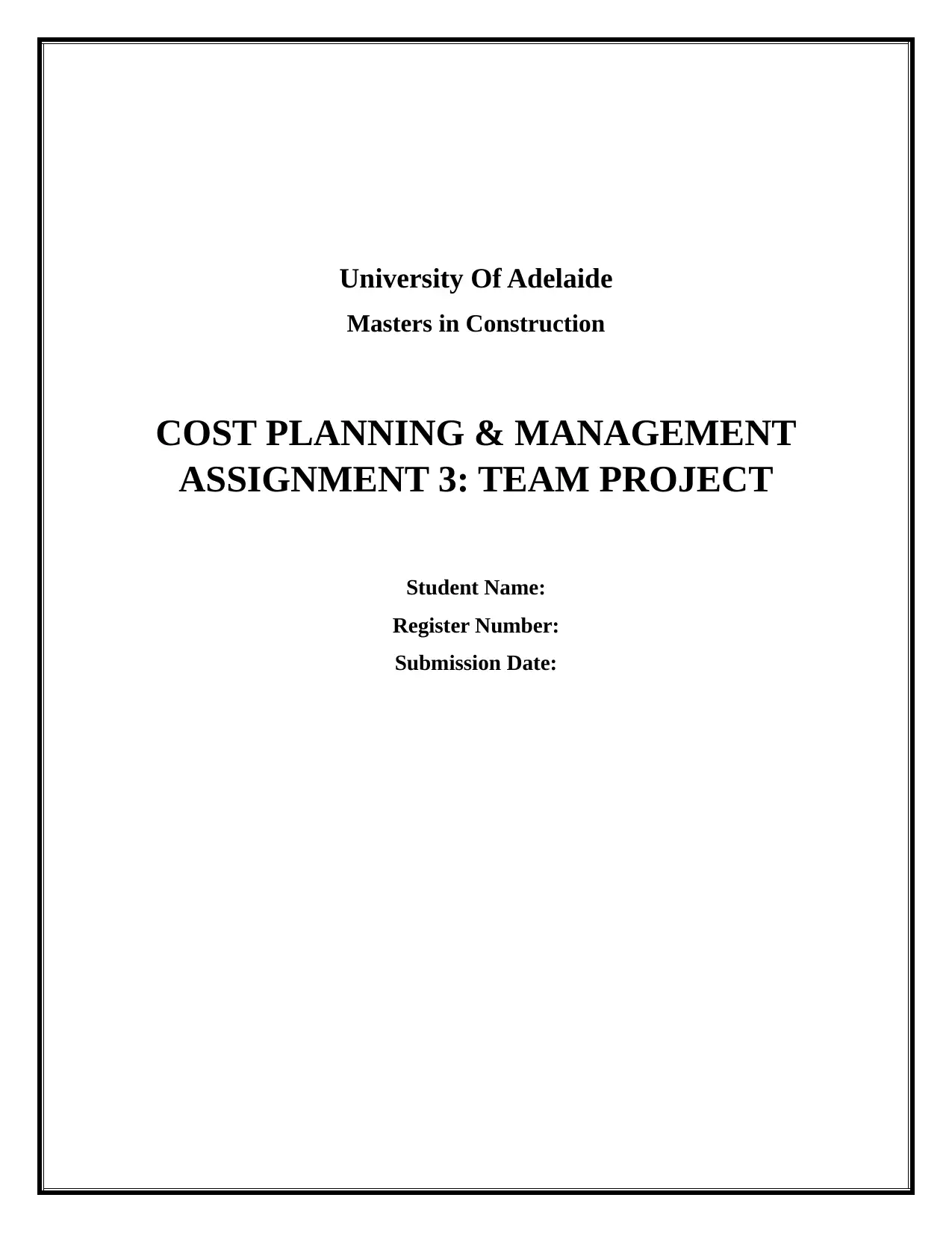
University Of Adelaide
Masters in Construction
COST PLANNING & MANAGEMENT
ASSIGNMENT 3: TEAM PROJECT
Student Name:
Register Number:
Submission Date:
Masters in Construction
COST PLANNING & MANAGEMENT
ASSIGNMENT 3: TEAM PROJECT
Student Name:
Register Number:
Submission Date:
Paraphrase This Document
Need a fresh take? Get an instant paraphrase of this document with our AI Paraphraser
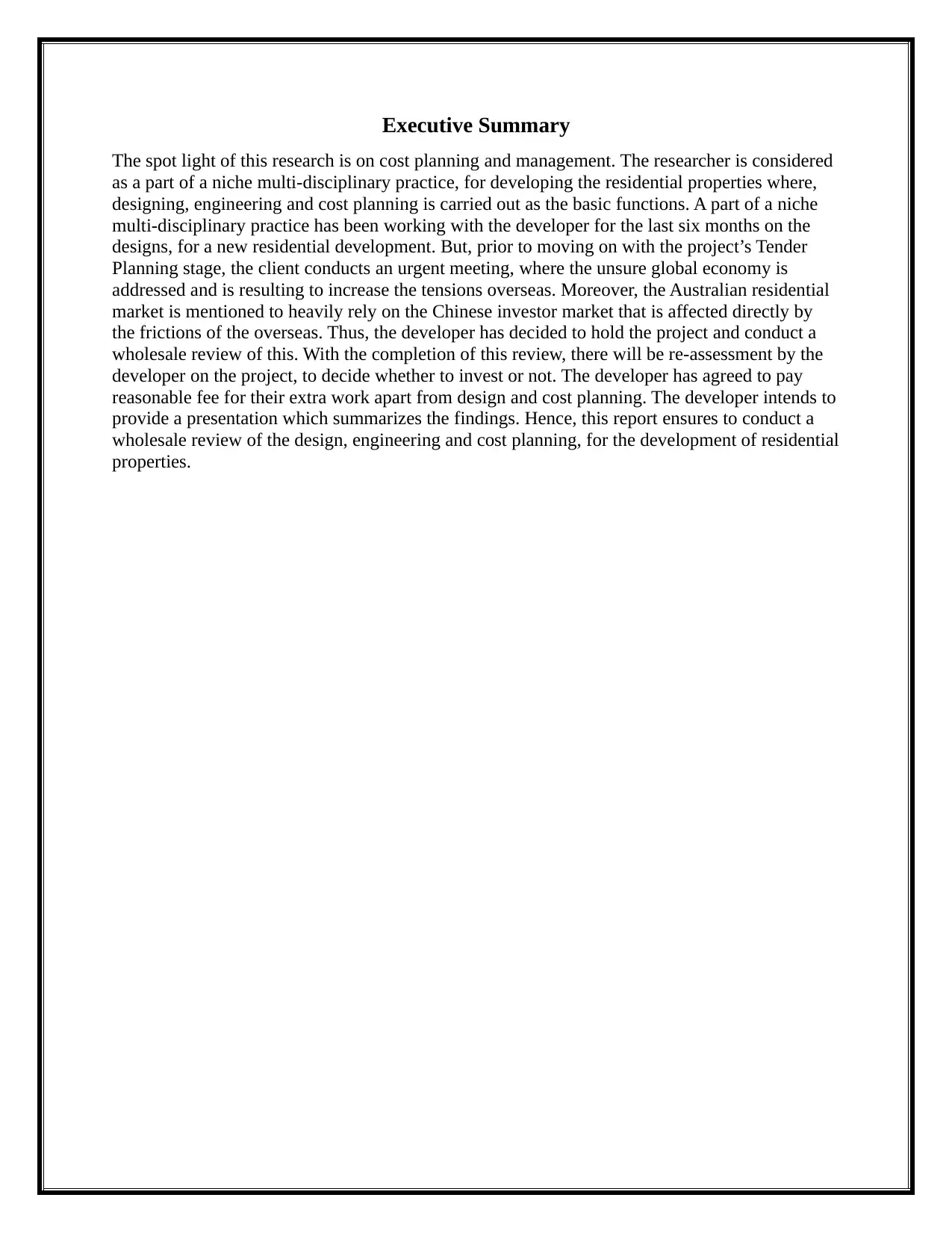
Executive Summary
The spot light of this research is on cost planning and management. The researcher is considered
as a part of a niche multi-disciplinary practice, for developing the residential properties where,
designing, engineering and cost planning is carried out as the basic functions. A part of a niche
multi-disciplinary practice has been working with the developer for the last six months on the
designs, for a new residential development. But, prior to moving on with the project’s Tender
Planning stage, the client conducts an urgent meeting, where the unsure global economy is
addressed and is resulting to increase the tensions overseas. Moreover, the Australian residential
market is mentioned to heavily rely on the Chinese investor market that is affected directly by
the frictions of the overseas. Thus, the developer has decided to hold the project and conduct a
wholesale review of this. With the completion of this review, there will be re-assessment by the
developer on the project, to decide whether to invest or not. The developer has agreed to pay
reasonable fee for their extra work apart from design and cost planning. The developer intends to
provide a presentation which summarizes the findings. Hence, this report ensures to conduct a
wholesale review of the design, engineering and cost planning, for the development of residential
properties.
The spot light of this research is on cost planning and management. The researcher is considered
as a part of a niche multi-disciplinary practice, for developing the residential properties where,
designing, engineering and cost planning is carried out as the basic functions. A part of a niche
multi-disciplinary practice has been working with the developer for the last six months on the
designs, for a new residential development. But, prior to moving on with the project’s Tender
Planning stage, the client conducts an urgent meeting, where the unsure global economy is
addressed and is resulting to increase the tensions overseas. Moreover, the Australian residential
market is mentioned to heavily rely on the Chinese investor market that is affected directly by
the frictions of the overseas. Thus, the developer has decided to hold the project and conduct a
wholesale review of this. With the completion of this review, there will be re-assessment by the
developer on the project, to decide whether to invest or not. The developer has agreed to pay
reasonable fee for their extra work apart from design and cost planning. The developer intends to
provide a presentation which summarizes the findings. Hence, this report ensures to conduct a
wholesale review of the design, engineering and cost planning, for the development of residential
properties.
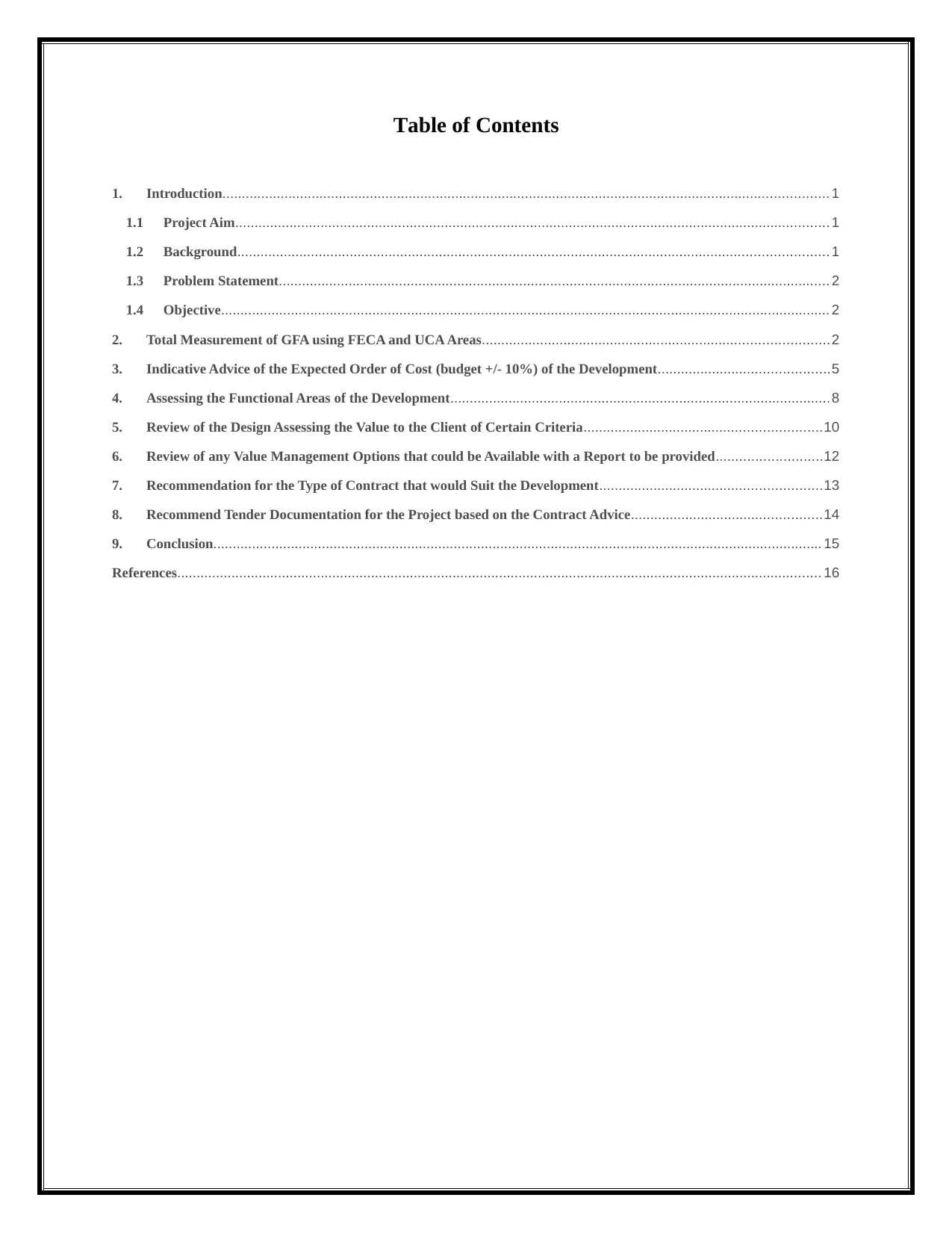
Table of Contents
1. Introduction............................................................................................................................................................ 1
1.1 Project Aim......................................................................................................................................................... 1
1.2 Background........................................................................................................................................................ 1
1.3 Problem Statement.............................................................................................................................................. 2
1.4 Objective............................................................................................................................................................. 2
2. Total Measurement of GFA using FECA and UCA Areas.........................................................................................2
3. Indicative Advice of the Expected Order of Cost (budget +/- 10%) of the Development............................................5
4. Assessing the Functional Areas of the Development..................................................................................................8
5. Review of the Design Assessing the Value to the Client of Certain Criteria.............................................................10
6. Review of any Value Management Options that could be Available with a Report to be provided...........................12
7. Recommendation for the Type of Contract that would Suit the Development.........................................................13
8. Recommend Tender Documentation for the Project based on the Contract Advice.................................................14
9. Conclusion............................................................................................................................................................. 15
References...................................................................................................................................................................... 16
1. Introduction............................................................................................................................................................ 1
1.1 Project Aim......................................................................................................................................................... 1
1.2 Background........................................................................................................................................................ 1
1.3 Problem Statement.............................................................................................................................................. 2
1.4 Objective............................................................................................................................................................. 2
2. Total Measurement of GFA using FECA and UCA Areas.........................................................................................2
3. Indicative Advice of the Expected Order of Cost (budget +/- 10%) of the Development............................................5
4. Assessing the Functional Areas of the Development..................................................................................................8
5. Review of the Design Assessing the Value to the Client of Certain Criteria.............................................................10
6. Review of any Value Management Options that could be Available with a Report to be provided...........................12
7. Recommendation for the Type of Contract that would Suit the Development.........................................................13
8. Recommend Tender Documentation for the Project based on the Contract Advice.................................................14
9. Conclusion............................................................................................................................................................. 15
References...................................................................................................................................................................... 16
⊘ This is a preview!⊘
Do you want full access?
Subscribe today to unlock all pages.

Trusted by 1+ million students worldwide
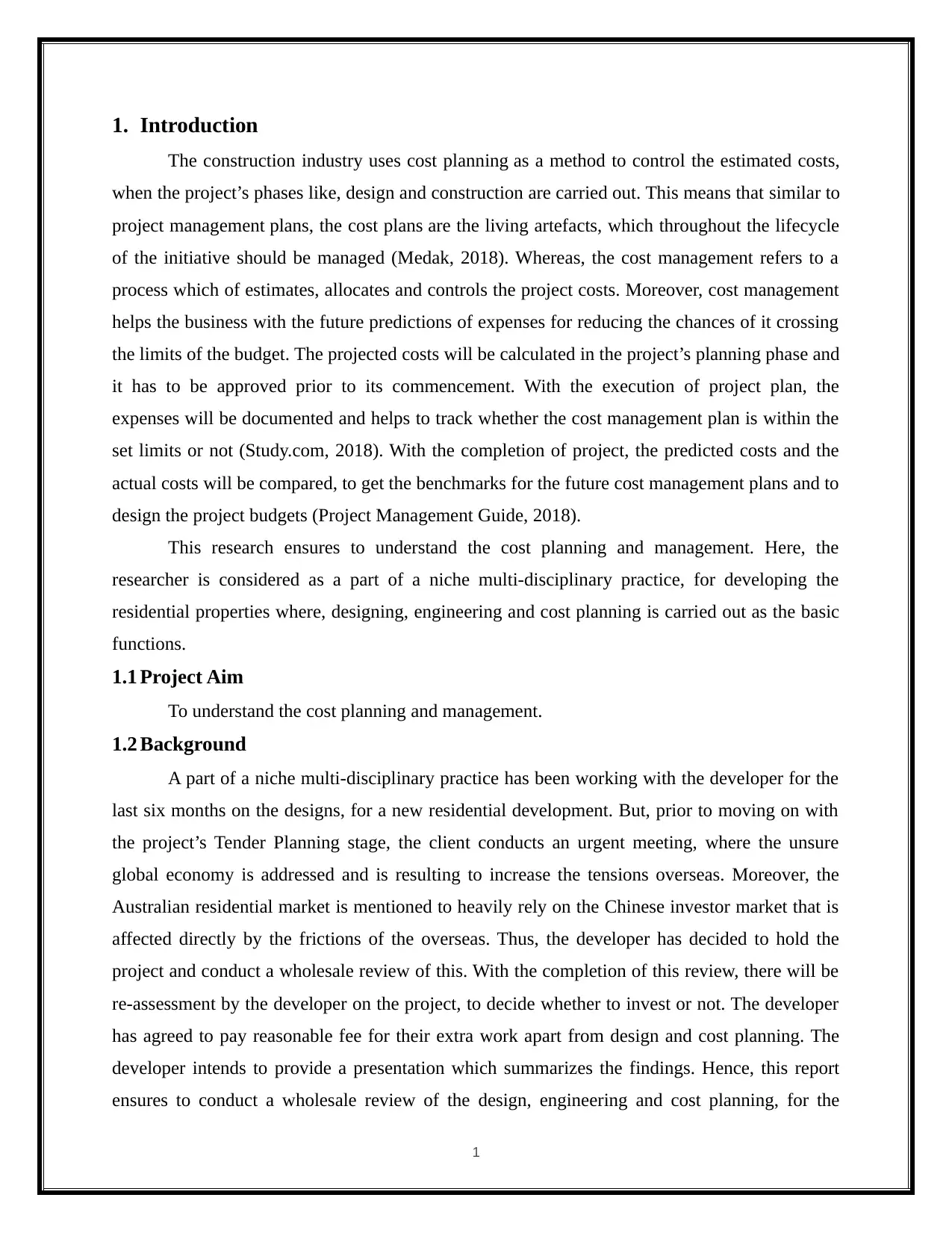
1. Introduction
The construction industry uses cost planning as a method to control the estimated costs,
when the project’s phases like, design and construction are carried out. This means that similar to
project management plans, the cost plans are the living artefacts, which throughout the lifecycle
of the initiative should be managed (Medak, 2018). Whereas, the cost management refers to a
process which of estimates, allocates and controls the project costs. Moreover, cost management
helps the business with the future predictions of expenses for reducing the chances of it crossing
the limits of the budget. The projected costs will be calculated in the project’s planning phase and
it has to be approved prior to its commencement. With the execution of project plan, the
expenses will be documented and helps to track whether the cost management plan is within the
set limits or not (Study.com, 2018). With the completion of project, the predicted costs and the
actual costs will be compared, to get the benchmarks for the future cost management plans and to
design the project budgets (Project Management Guide, 2018).
This research ensures to understand the cost planning and management. Here, the
researcher is considered as a part of a niche multi-disciplinary practice, for developing the
residential properties where, designing, engineering and cost planning is carried out as the basic
functions.
1.1 Project Aim
To understand the cost planning and management.
1.2 Background
A part of a niche multi-disciplinary practice has been working with the developer for the
last six months on the designs, for a new residential development. But, prior to moving on with
the project’s Tender Planning stage, the client conducts an urgent meeting, where the unsure
global economy is addressed and is resulting to increase the tensions overseas. Moreover, the
Australian residential market is mentioned to heavily rely on the Chinese investor market that is
affected directly by the frictions of the overseas. Thus, the developer has decided to hold the
project and conduct a wholesale review of this. With the completion of this review, there will be
re-assessment by the developer on the project, to decide whether to invest or not. The developer
has agreed to pay reasonable fee for their extra work apart from design and cost planning. The
developer intends to provide a presentation which summarizes the findings. Hence, this report
ensures to conduct a wholesale review of the design, engineering and cost planning, for the
1
The construction industry uses cost planning as a method to control the estimated costs,
when the project’s phases like, design and construction are carried out. This means that similar to
project management plans, the cost plans are the living artefacts, which throughout the lifecycle
of the initiative should be managed (Medak, 2018). Whereas, the cost management refers to a
process which of estimates, allocates and controls the project costs. Moreover, cost management
helps the business with the future predictions of expenses for reducing the chances of it crossing
the limits of the budget. The projected costs will be calculated in the project’s planning phase and
it has to be approved prior to its commencement. With the execution of project plan, the
expenses will be documented and helps to track whether the cost management plan is within the
set limits or not (Study.com, 2018). With the completion of project, the predicted costs and the
actual costs will be compared, to get the benchmarks for the future cost management plans and to
design the project budgets (Project Management Guide, 2018).
This research ensures to understand the cost planning and management. Here, the
researcher is considered as a part of a niche multi-disciplinary practice, for developing the
residential properties where, designing, engineering and cost planning is carried out as the basic
functions.
1.1 Project Aim
To understand the cost planning and management.
1.2 Background
A part of a niche multi-disciplinary practice has been working with the developer for the
last six months on the designs, for a new residential development. But, prior to moving on with
the project’s Tender Planning stage, the client conducts an urgent meeting, where the unsure
global economy is addressed and is resulting to increase the tensions overseas. Moreover, the
Australian residential market is mentioned to heavily rely on the Chinese investor market that is
affected directly by the frictions of the overseas. Thus, the developer has decided to hold the
project and conduct a wholesale review of this. With the completion of this review, there will be
re-assessment by the developer on the project, to decide whether to invest or not. The developer
has agreed to pay reasonable fee for their extra work apart from design and cost planning. The
developer intends to provide a presentation which summarizes the findings. Hence, this report
ensures to conduct a wholesale review of the design, engineering and cost planning, for the
1
Paraphrase This Document
Need a fresh take? Get an instant paraphrase of this document with our AI Paraphraser
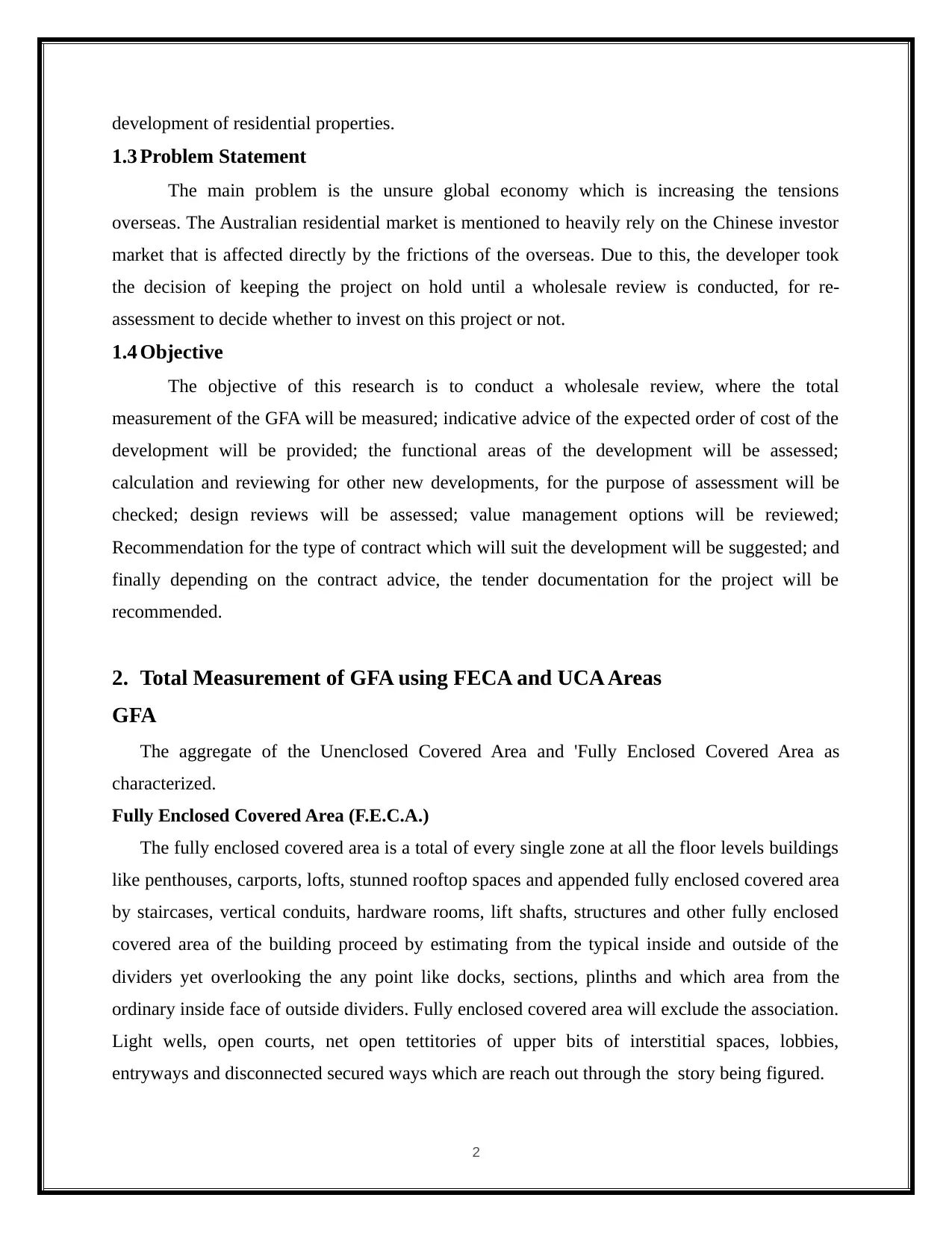
development of residential properties.
1.3 Problem Statement
The main problem is the unsure global economy which is increasing the tensions
overseas. The Australian residential market is mentioned to heavily rely on the Chinese investor
market that is affected directly by the frictions of the overseas. Due to this, the developer took
the decision of keeping the project on hold until a wholesale review is conducted, for re-
assessment to decide whether to invest on this project or not.
1.4 Objective
The objective of this research is to conduct a wholesale review, where the total
measurement of the GFA will be measured; indicative advice of the expected order of cost of the
development will be provided; the functional areas of the development will be assessed;
calculation and reviewing for other new developments, for the purpose of assessment will be
checked; design reviews will be assessed; value management options will be reviewed;
Recommendation for the type of contract which will suit the development will be suggested; and
finally depending on the contract advice, the tender documentation for the project will be
recommended.
2. Total Measurement of GFA using FECA and UCA Areas
GFA
The aggregate of the Unenclosed Covered Area and 'Fully Enclosed Covered Area as
characterized.
Fully Enclosed Covered Area (F.E.C.A.)
The fully enclosed covered area is a total of every single zone at all the floor levels buildings
like penthouses, carports, lofts, stunned rooftop spaces and appended fully enclosed covered area
by staircases, vertical conduits, hardware rooms, lift shafts, structures and other fully enclosed
covered area of the building proceed by estimating from the typical inside and outside of the
dividers yet overlooking the any point like docks, sections, plinths and which area from the
ordinary inside face of outside dividers. Fully enclosed covered area will exclude the association.
Light wells, open courts, net open tettitories of upper bits of interstitial spaces, lobbies,
entryways and disconnected secured ways which are reach out through the story being figured.
2
1.3 Problem Statement
The main problem is the unsure global economy which is increasing the tensions
overseas. The Australian residential market is mentioned to heavily rely on the Chinese investor
market that is affected directly by the frictions of the overseas. Due to this, the developer took
the decision of keeping the project on hold until a wholesale review is conducted, for re-
assessment to decide whether to invest on this project or not.
1.4 Objective
The objective of this research is to conduct a wholesale review, where the total
measurement of the GFA will be measured; indicative advice of the expected order of cost of the
development will be provided; the functional areas of the development will be assessed;
calculation and reviewing for other new developments, for the purpose of assessment will be
checked; design reviews will be assessed; value management options will be reviewed;
Recommendation for the type of contract which will suit the development will be suggested; and
finally depending on the contract advice, the tender documentation for the project will be
recommended.
2. Total Measurement of GFA using FECA and UCA Areas
GFA
The aggregate of the Unenclosed Covered Area and 'Fully Enclosed Covered Area as
characterized.
Fully Enclosed Covered Area (F.E.C.A.)
The fully enclosed covered area is a total of every single zone at all the floor levels buildings
like penthouses, carports, lofts, stunned rooftop spaces and appended fully enclosed covered area
by staircases, vertical conduits, hardware rooms, lift shafts, structures and other fully enclosed
covered area of the building proceed by estimating from the typical inside and outside of the
dividers yet overlooking the any point like docks, sections, plinths and which area from the
ordinary inside face of outside dividers. Fully enclosed covered area will exclude the association.
Light wells, open courts, net open tettitories of upper bits of interstitial spaces, lobbies,
entryways and disconnected secured ways which are reach out through the story being figured.
2
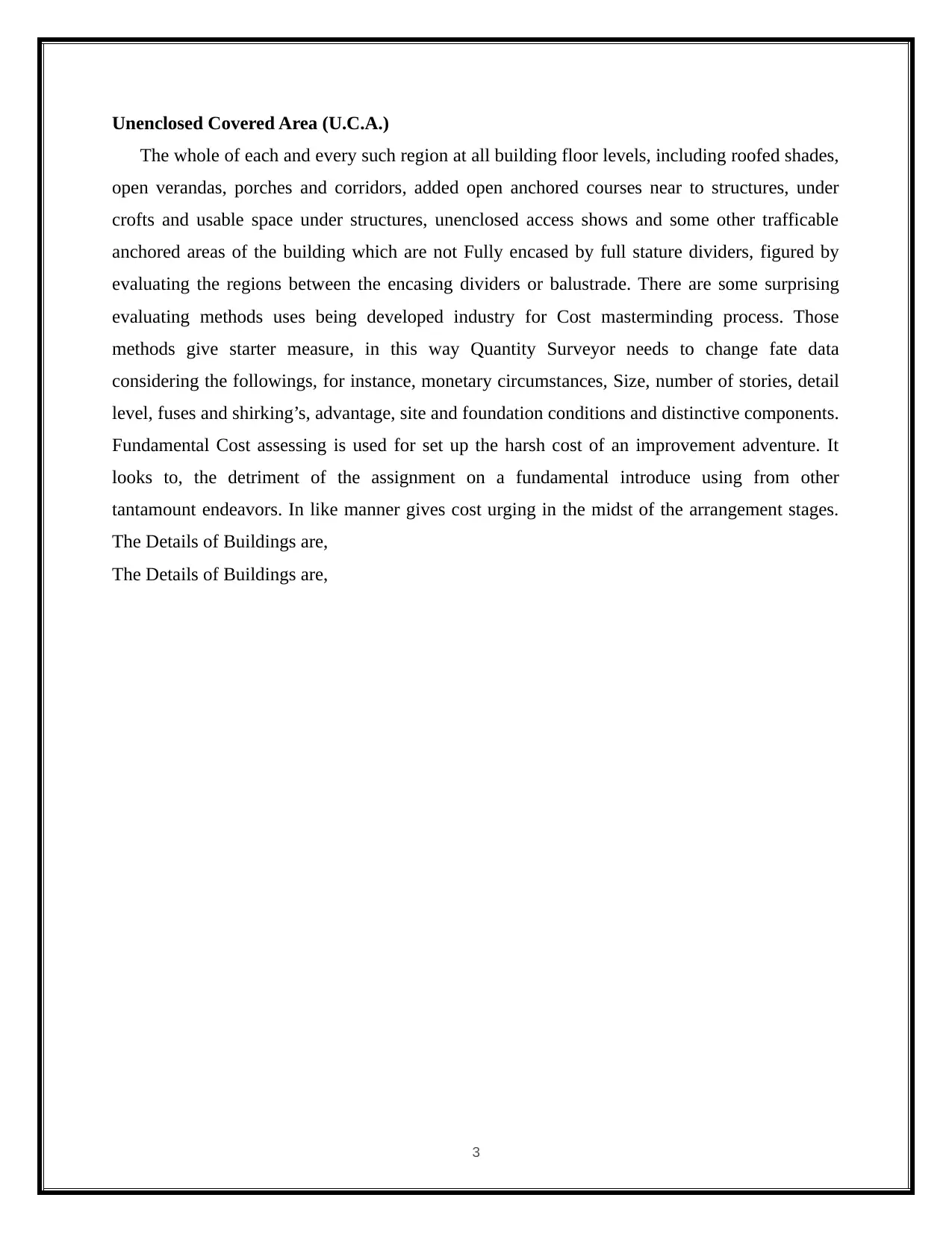
Unenclosed Covered Area (U.C.A.)
The whole of each and every such region at all building floor levels, including roofed shades,
open verandas, porches and corridors, added open anchored courses near to structures, under
crofts and usable space under structures, unenclosed access shows and some other trafficable
anchored areas of the building which are not Fully encased by full stature dividers, figured by
evaluating the regions between the encasing dividers or balustrade. There are some surprising
evaluating methods uses being developed industry for Cost masterminding process. Those
methods give starter measure, in this way Quantity Surveyor needs to change fate data
considering the followings, for instance, monetary circumstances, Size, number of stories, detail
level, fuses and shirking’s, advantage, site and foundation conditions and distinctive components.
Fundamental Cost assessing is used for set up the harsh cost of an improvement adventure. It
looks to, the detriment of the assignment on a fundamental introduce using from other
tantamount endeavors. In like manner gives cost urging in the midst of the arrangement stages.
The Details of Buildings are,
The Details of Buildings are,
3
The whole of each and every such region at all building floor levels, including roofed shades,
open verandas, porches and corridors, added open anchored courses near to structures, under
crofts and usable space under structures, unenclosed access shows and some other trafficable
anchored areas of the building which are not Fully encased by full stature dividers, figured by
evaluating the regions between the encasing dividers or balustrade. There are some surprising
evaluating methods uses being developed industry for Cost masterminding process. Those
methods give starter measure, in this way Quantity Surveyor needs to change fate data
considering the followings, for instance, monetary circumstances, Size, number of stories, detail
level, fuses and shirking’s, advantage, site and foundation conditions and distinctive components.
Fundamental Cost assessing is used for set up the harsh cost of an improvement adventure. It
looks to, the detriment of the assignment on a fundamental introduce using from other
tantamount endeavors. In like manner gives cost urging in the midst of the arrangement stages.
The Details of Buildings are,
The Details of Buildings are,
3
⊘ This is a preview!⊘
Do you want full access?
Subscribe today to unlock all pages.

Trusted by 1+ million students worldwide
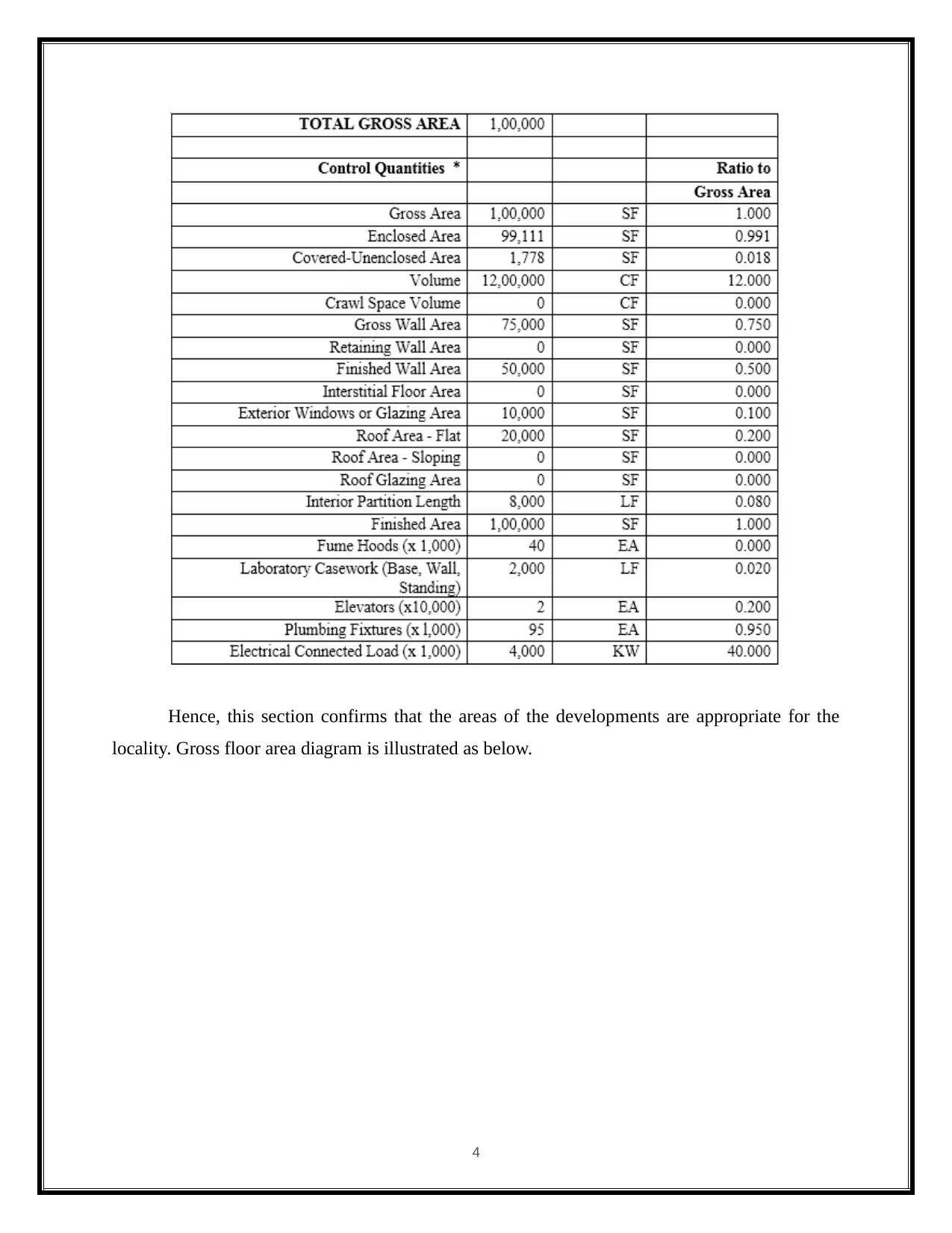
Hence, this section confirms that the areas of the developments are appropriate for the
locality. Gross floor area diagram is illustrated as below.
4
locality. Gross floor area diagram is illustrated as below.
4
Paraphrase This Document
Need a fresh take? Get an instant paraphrase of this document with our AI Paraphraser
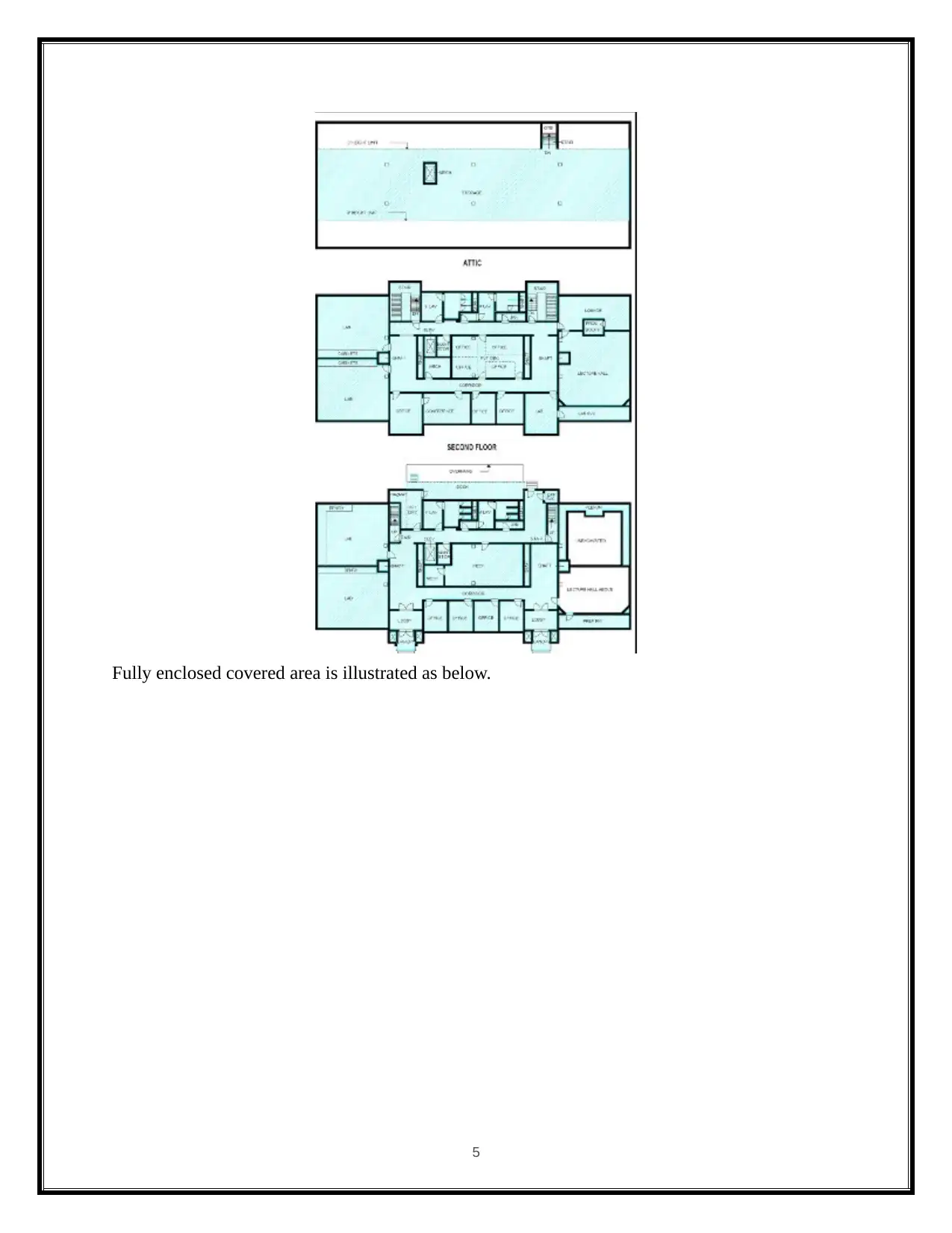
Fully enclosed covered area is illustrated as below.
5
5
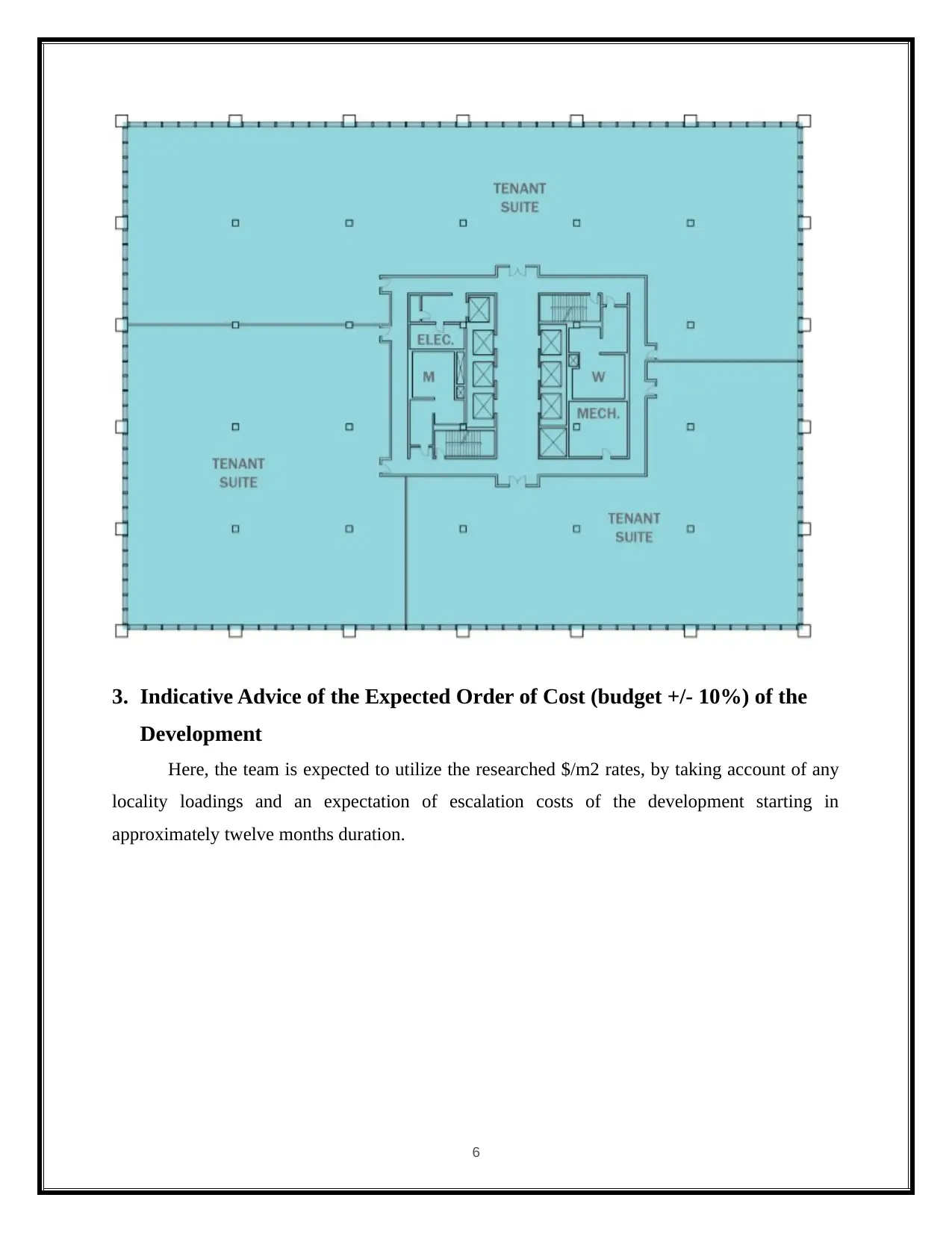
3. Indicative Advice of the Expected Order of Cost (budget +/- 10%) of the
Development
Here, the team is expected to utilize the researched $/m2 rates, by taking account of any
locality loadings and an expectation of escalation costs of the development starting in
approximately twelve months duration.
6
Development
Here, the team is expected to utilize the researched $/m2 rates, by taking account of any
locality loadings and an expectation of escalation costs of the development starting in
approximately twelve months duration.
6
⊘ This is a preview!⊘
Do you want full access?
Subscribe today to unlock all pages.

Trusted by 1+ million students worldwide
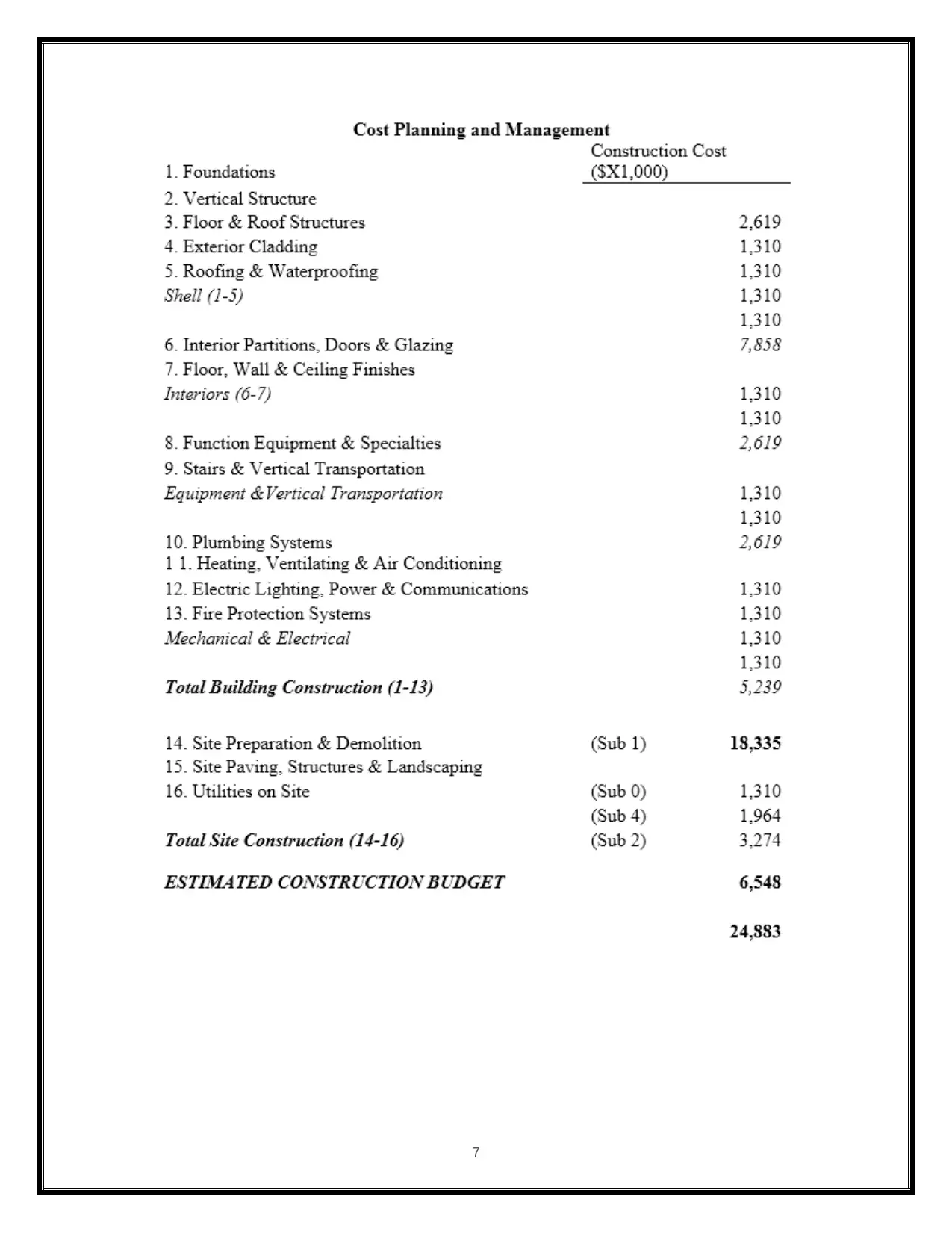
7
Paraphrase This Document
Need a fresh take? Get an instant paraphrase of this document with our AI Paraphraser
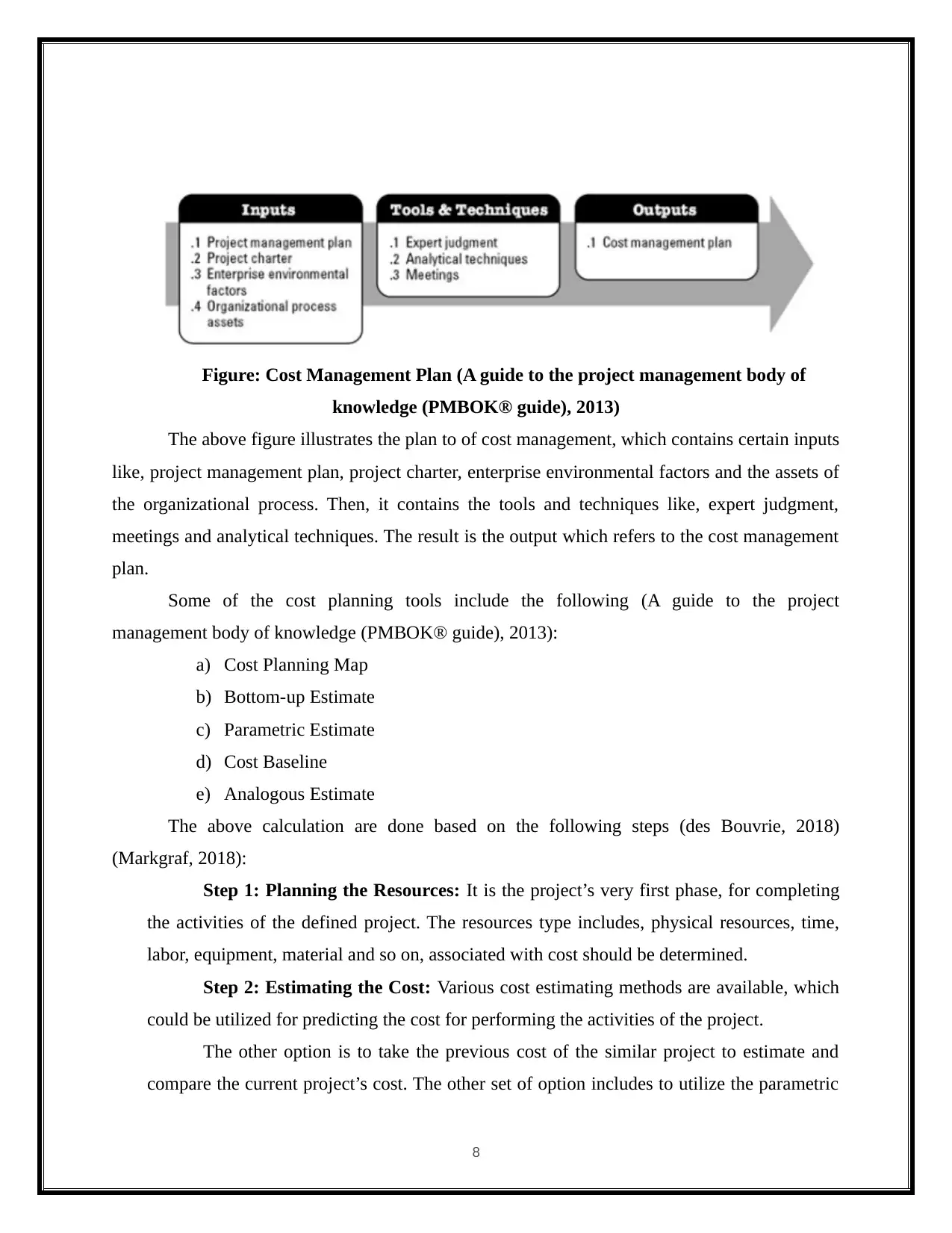
Figure: Cost Management Plan (A guide to the project management body of
knowledge (PMBOK® guide), 2013)
The above figure illustrates the plan to of cost management, which contains certain inputs
like, project management plan, project charter, enterprise environmental factors and the assets of
the organizational process. Then, it contains the tools and techniques like, expert judgment,
meetings and analytical techniques. The result is the output which refers to the cost management
plan.
Some of the cost planning tools include the following (A guide to the project
management body of knowledge (PMBOK® guide), 2013):
a) Cost Planning Map
b) Bottom-up Estimate
c) Parametric Estimate
d) Cost Baseline
e) Analogous Estimate
The above calculation are done based on the following steps (des Bouvrie, 2018)
(Markgraf, 2018):
Step 1: Planning the Resources: It is the project’s very first phase, for completing
the activities of the defined project. The resources type includes, physical resources, time,
labor, equipment, material and so on, associated with cost should be determined.
Step 2: Estimating the Cost: Various cost estimating methods are available, which
could be utilized for predicting the cost for performing the activities of the project.
The other option is to take the previous cost of the similar project to estimate and
compare the current project’s cost. The other set of option includes to utilize the parametric
8
knowledge (PMBOK® guide), 2013)
The above figure illustrates the plan to of cost management, which contains certain inputs
like, project management plan, project charter, enterprise environmental factors and the assets of
the organizational process. Then, it contains the tools and techniques like, expert judgment,
meetings and analytical techniques. The result is the output which refers to the cost management
plan.
Some of the cost planning tools include the following (A guide to the project
management body of knowledge (PMBOK® guide), 2013):
a) Cost Planning Map
b) Bottom-up Estimate
c) Parametric Estimate
d) Cost Baseline
e) Analogous Estimate
The above calculation are done based on the following steps (des Bouvrie, 2018)
(Markgraf, 2018):
Step 1: Planning the Resources: It is the project’s very first phase, for completing
the activities of the defined project. The resources type includes, physical resources, time,
labor, equipment, material and so on, associated with cost should be determined.
Step 2: Estimating the Cost: Various cost estimating methods are available, which
could be utilized for predicting the cost for performing the activities of the project.
The other option is to take the previous cost of the similar project to estimate and
compare the current project’s cost. The other set of option includes to utilize the parametric
8
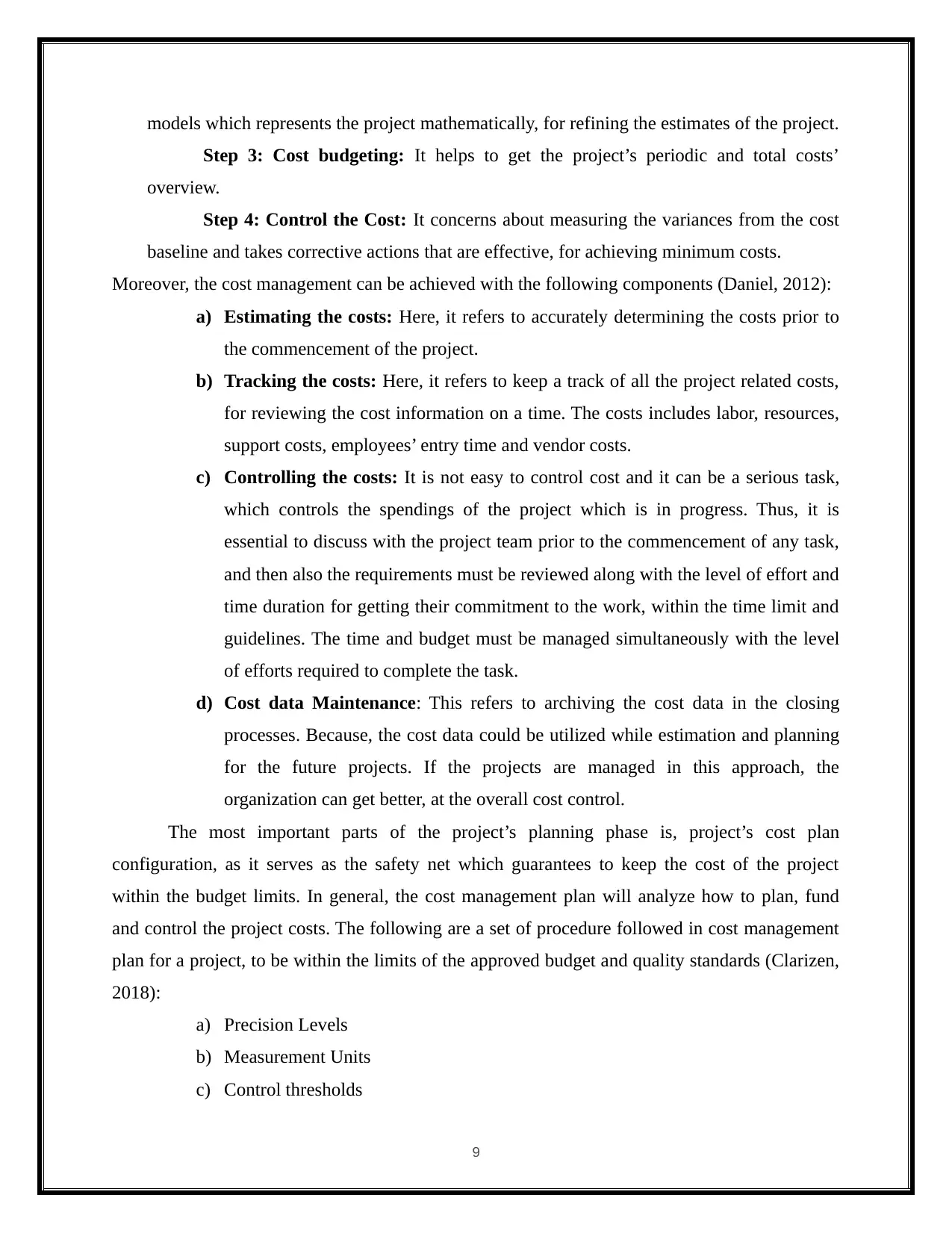
models which represents the project mathematically, for refining the estimates of the project.
Step 3: Cost budgeting: It helps to get the project’s periodic and total costs’
overview.
Step 4: Control the Cost: It concerns about measuring the variances from the cost
baseline and takes corrective actions that are effective, for achieving minimum costs.
Moreover, the cost management can be achieved with the following components (Daniel, 2012):
a) Estimating the costs: Here, it refers to accurately determining the costs prior to
the commencement of the project.
b) Tracking the costs: Here, it refers to keep a track of all the project related costs,
for reviewing the cost information on a time. The costs includes labor, resources,
support costs, employees’ entry time and vendor costs.
c) Controlling the costs: It is not easy to control cost and it can be a serious task,
which controls the spendings of the project which is in progress. Thus, it is
essential to discuss with the project team prior to the commencement of any task,
and then also the requirements must be reviewed along with the level of effort and
time duration for getting their commitment to the work, within the time limit and
guidelines. The time and budget must be managed simultaneously with the level
of efforts required to complete the task.
d) Cost data Maintenance: This refers to archiving the cost data in the closing
processes. Because, the cost data could be utilized while estimation and planning
for the future projects. If the projects are managed in this approach, the
organization can get better, at the overall cost control.
The most important parts of the project’s planning phase is, project’s cost plan
configuration, as it serves as the safety net which guarantees to keep the cost of the project
within the budget limits. In general, the cost management plan will analyze how to plan, fund
and control the project costs. The following are a set of procedure followed in cost management
plan for a project, to be within the limits of the approved budget and quality standards (Clarizen,
2018):
a) Precision Levels
b) Measurement Units
c) Control thresholds
9
Step 3: Cost budgeting: It helps to get the project’s periodic and total costs’
overview.
Step 4: Control the Cost: It concerns about measuring the variances from the cost
baseline and takes corrective actions that are effective, for achieving minimum costs.
Moreover, the cost management can be achieved with the following components (Daniel, 2012):
a) Estimating the costs: Here, it refers to accurately determining the costs prior to
the commencement of the project.
b) Tracking the costs: Here, it refers to keep a track of all the project related costs,
for reviewing the cost information on a time. The costs includes labor, resources,
support costs, employees’ entry time and vendor costs.
c) Controlling the costs: It is not easy to control cost and it can be a serious task,
which controls the spendings of the project which is in progress. Thus, it is
essential to discuss with the project team prior to the commencement of any task,
and then also the requirements must be reviewed along with the level of effort and
time duration for getting their commitment to the work, within the time limit and
guidelines. The time and budget must be managed simultaneously with the level
of efforts required to complete the task.
d) Cost data Maintenance: This refers to archiving the cost data in the closing
processes. Because, the cost data could be utilized while estimation and planning
for the future projects. If the projects are managed in this approach, the
organization can get better, at the overall cost control.
The most important parts of the project’s planning phase is, project’s cost plan
configuration, as it serves as the safety net which guarantees to keep the cost of the project
within the budget limits. In general, the cost management plan will analyze how to plan, fund
and control the project costs. The following are a set of procedure followed in cost management
plan for a project, to be within the limits of the approved budget and quality standards (Clarizen,
2018):
a) Precision Levels
b) Measurement Units
c) Control thresholds
9
⊘ This is a preview!⊘
Do you want full access?
Subscribe today to unlock all pages.

Trusted by 1+ million students worldwide
1 out of 22
Related Documents
Your All-in-One AI-Powered Toolkit for Academic Success.
+13062052269
info@desklib.com
Available 24*7 on WhatsApp / Email
![[object Object]](/_next/static/media/star-bottom.7253800d.svg)
Unlock your academic potential
Copyright © 2020–2025 A2Z Services. All Rights Reserved. Developed and managed by ZUCOL.





